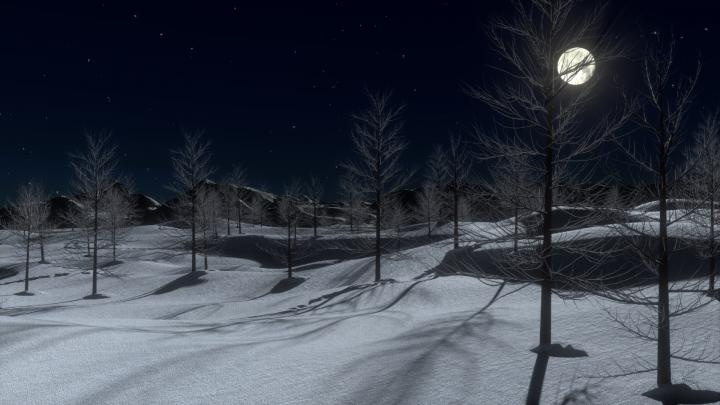February is the month of romance and love! There’s a special treat on Valentine’s Day itself—grab your sweetheart (and some warm clothing) and head outside to see Jupiter and the Moon kiss. See all Bob’s highlights of the February 2024 sky.
Highlights
Jupiter dominates the night sky this month; the Giant Planet rises at twilight and sets near midnight local time early in the month and by 10:30 P.M. late in the month.
Venus is the bright “morning star” this month. Our neighboring planet rises in the morning just before the Sun (look east) at -4 magnitude. Mars follows but it’s quite dim to the naked eye.
Don’t forget that this February brings a Leap Day! Since it takes 365.25 days for Earth to orbit the Sun, our calendar needs to make up for ¼ day each year. The solution is to add one day to February (the 29th) to years that are divisible by 4. Read more about Leap Years.
February 2: Last Quarter Moon
Groundhog Day, February 2, 2024, brings us the last quarter Moon at 6:18 P.M. Did Puxataney Phil see his shadow? Learn more about Groundhog Day and the famous rodent’s predictions.
February 9: New Moon
The New Moon peaks on February 9 at 5:59 P.M. The New Moon is sometimes seen as a period of rebirth… maybe it’s time to consider planting some seeds in anticipation of the gardening season ahead. Check out our Planting Calendar to see if it’s time to get those seedlings started.
February 11-13: The Crescent Moon Smiles!
Typically, the crescent Moon looks like an archer’s bow, but for these special few days, the moon appears to smile in the fading twilight. Make time to head out and see it… and let it bring a smile to your face!
February 14: Valentine’s Gift
On the evening of Valentine’s Day, you can observe the planetary giant, Jupiter, hovering just next to the left of the Moon. It’s a beautiful sight; consider toasting the heavens with a glass of champagne over a romantic dinner. Check the Almanac’s Bright Planets Calculator to learn more about when the planets can be easily seen.
On the 15th, Jupiter appears just below the waxing crescent Moon.
February 16: First Quarter Moon
February 16 at 10:01 A.M., the first Quarter Moon is on full display! Have you ever wondered why it isn’t called a Half Moon? We have the scoop.
February 20 to 24: Planetary Conjunction
In the morning hours of February 20-24, Earth’s two nearest neighbors will come together in conjunction. Look to the southeast to see Mars and Venus visiting one another.
February 24: The Full Snow Moon
The full Moon of February crests on Saturday, February 24 at 7:30 A.M. Here at the Almanac, we’ve long called February’s Moon the ”Snow Moon” due to the typically heavy snowfall that occurs this month in the Northern Hemisphere. Other Native American names for this Moon are: Make Branches Fall Into Pieces Moon, Raccoon Moon, and Hunger Moon. Read more about the February Snow Moon here!

Orion the Hunter and Other February Constellations
The brighter constellation in the night sky is Orion, the Hunter of Greek mythology. Look first for that bright belt of three stars. The hunter’s shoulder is marked by its bright red star Betelgeuse, and its knee is marked by a blue-white star Rigel. See our February Sky Map, which is all about the constellation Orion.
 Follow the belt of Orion down and left to find blue-white Sirius, the brightest star in the night sky. Sirius lies in the constellation Canis Major, the Great Dog and companion to Orion. See my tips on finding Sirius, the brightest star in the February sky.
Follow the belt of Orion down and left to find blue-white Sirius, the brightest star in the night sky. Sirius lies in the constellation Canis Major, the Great Dog and companion to Orion. See my tips on finding Sirius, the brightest star in the February sky.
Use Orion’s three Belt stars to point northwest to the red star Aldebaran and the Hyades star cluster, then to the Pleiades star cluster.
Then, travel southeast from the Belt stars to the brightest star in the night sky, Sirius. Above and left of Sirius is another bright star, a yellowish giant named Procyon. Procyon is part of the constellation Canis Minor, the smaller dog and Orion’s second companion. Procyon, Sirius, and Betelgeuse form a geometrical pattern called the Winter Triangle.

This is also a good time to view the Big Dipper far above the northeast horizon. It will climb upward during the evening hours to reach its high point for the night around midnight. Draw a line from its two end bowl stars upwards to the Polaris, the North Star. See my tips on finding the Big Dipper and the North Star.



 Follow the belt of Orion down and left to find blue-white Sirius, the brightest star in the night sky. Sirius lies in the constellation Canis Major, the Great Dog and companion to Orion.
Follow the belt of Orion down and left to find blue-white Sirius, the brightest star in the night sky. Sirius lies in the constellation Canis Major, the Great Dog and companion to Orion. 








